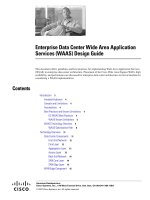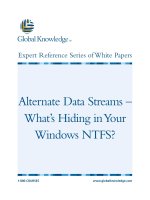Tài liệu Alternate Data Streams – What’s Hiding in Your Windows NTFS? pdf
Bạn đang xem bản rút gọn của tài liệu. Xem và tải ngay bản đầy đủ của tài liệu tại đây (546.62 KB, 10 trang )
Alternate Data Streams –
What’s Hiding in Your
Windows NTFS?
1-800-COURSES
www.globalknowledge.com
Expert Reference Series of White Papers
Introduction
Hackers and malware authors have a strong motivation to keep you from finding their malicious software on
your system. If you find it, you can delete it. If you delete it, the malware author doesn’t make money—yes,
this is a for-profit business. Panda software, a respected anti-virus and anti-malware vendor, reports that from
January – March of 2006, 70% of the malware released on the Internet was trying to make money for the
authors in one way or another. For additional information on that report, visit
http://www
.pandasoftware
.com/about_panda/press_room/Quarterly+P
andaLabs+Report.htm.
The old ploy of “hide in plain site” isn’t as reliable as it needs to be for the profit-minded malware author. For
example, placing a malicious executable in a file called scsi.dll under the directory
c:\winnt\system32\os2\dll
might work fine in Windows 2000, since few people would be inclined to
mess with that file
. But that filename does not work in Windows XP because the
system32\os2
directory
does not exist in XP. Malware authors want a more reliable means of hiding malicious files.
Enter Alternate Data Streams or
ADSs (you will also find information referring to them as NTFS Streams). Every
NTFS file system is capable of creating and maintaining ADSs. This is a feature added to the NTFS file system
for compatibility with Macintosh computers. The Mac maintains certain information about a file that Windows
does not. When you share files between a Mac and Windows, that additional information is kept in an ADS on
the NTFS-based Windows system.
Of course
, anything that exists for a v
alid reason can be misused in an
invalid, malicious way.
ADSs seem to be the best kept secret of the Microsoft world. Very few people, including those holding
Microsoft certifications
,
are aw
are of them, although they are reasonably well understood in the computer
forensics community. This is made worse by the fact that much of the information available about ADSs on the
Internet is either out of date or simply wrong. Researching ADSs is extremely difficult. This paper will explain
the issues with ADSs, as well as how they can be created, executed, found, and removed. Because of the
amount of misinformation out there, everything in this paper has been verified on test systems.
The Details
With an ADS, one file is effectively hidden
behind
another file. The file in front is the only one visible in
Windows Explorer or via the
dir
command. In fact, the only telltale sign is that the date-time stamp of the
visible file changes to the time the ADS is created (even a one-way hash of the visible file using something like
MD5 does not change). Here are some important points to remember throughout this discussion:
Keith Palmgren, Global Knowledge Instructor, CISSP, Security+, TICSA
Alternate Data Streams –
What’s Hiding in Your Windows NTFS?
Copyright ©2006 NetIP
, Inc. All rights reserved.
Page 2
•
You can put an ADS behind another file or behind a directory.
• You can put multiple files behind a single file or directory.
• Copying or moving a file within the NTFS file system does not affect the ADS. The stream copies/moves
with the visible file to the new location. E-mailing the file as an attachment can destroy the ADS.
• The visible file is unaffected by the ADS. For example, placing an ADS behind the system calculator does
not affect the operation of the calculator.
• All examples in this document show how ADSs can be created from the command line. Functions in vari-
ous programming languages can also create and manipulate them, but we will not examine those func-
tions here.
As noted above and demonstrated below, the date-time stamp on the visible file changes when an ADS is cre-
ated behind it.
However, utilities exist to manipulate those date-time stamps and make them say anything you
want. If those utilities exist, then clearly the malware author could include similar functions in an install pro-
gram to reset date-time stamps. Two utilities to manipulate date-time stamps are:
• Attribute Magic (
• File
Tweak (
Creating an ADS is actually very simple. The command below will fork the system calculator behind a file in the
root directory file called somefile
.txt. The second command executes that copy of the calculator. (A much more
detailed example follows below.) This command does not affect the original system calculator—it creates a
copy of the calculator behind somefile.txt.
Notice the use of the colon in these commands:
type c:\windows\system32\calc.exe>c:\somefile.txt:calc.exe
start c:\somefile.txt:calc.exe
The command below would place the Notepad executable into an ADS behind a directory c:\ads (the directory
must already exist). You would execute the copy of notepad using the same start command syntax used above:
type c:\windows\system32\notepad.exe>c:\ads:notepad.exe
Unfortunately, until very recently, deleting ADSs was more of a problem. You had the following options:
• Move the file or directory to a FAT file system. This would destroy the stream. However, it would also
remove any special file permissions, and that could be a problem, if the malicious file is hidden behind a
critical directory such as system32.
•
Y
ou could delete the visible file or directory
. Again, if the malicious stream were hidden behind the sys-
tem32 directory
, that solution is less than desirable.
•You could use the commands below to get rid of an ADS behind a file named anyfile.txt in this example.
Note that these commands do not work with a directory:
Copyright ©2006 NetIP
, Inc. All rights reserved.
Page 3
r
en c:\anyfile.txt c:\temp.txt
type c:\temp.exe c:\anyfile.exe
del temp.exe
The Utilities
Fortunately, there is now a utility that will help you to delete Alternate Data Streams. If you visit
and scroll down the page, you will find the utility ADS
Spy. This is a graphical tool that can show you ADSs and let you select which of those ADSs to delete. Versions
1.11 and later allow you to scan a single directory, the Windows base folder only, or your entire hard drive. A
major advantage of ADS Spy is that it can delete ADSs from behind both files and directories.
A second utility, lads.exe is a command line utility. It does not delete ADSs, it only lists them. If you were to put
lads.exe in the
C:\
directory, the command below creates a file containing a listing of all the ADS files on your
system:
C:\lads.exe /S > C:\ads-list.txt
The /S tells lads to look in subdirectories. Without that, it only looks in the present directory. You can also spec-
ify a directory you want it to scan. Use
C:\lads /?
for all the options. You can download lads.exe from
/>Further Discussion
The existence of an ADS on your system is not necessarily malicious. We have identified at least three times
when an ADS will exist legitimately:
• Since they were invented for the purpose of tracking information on files shared between a Macintosh
operating system and NTFS, this will obviously create them legitimately.
• When you use Microsoft Internet Explorer (at least through version 6) to download and save files from
the Internet, the browser creates an ADS called Zone.Identifier. This file contains information about the
Internet zone from which the file w
as downloaded.
We have yet to discover why we might need that
information, but that is what it does. Contents of such a file often look like the following:
[ZoneTransfer]
ZoneId=3
• In the Windows XP Windows Explorer, if you choose the View –> Thumbnails option for pictures, it
appears to create the thumbnail as an ADS. These files have names similar to {4c8cc155-6c1e-11d1-
8e41-00c04fb9386d}.
V
ery informative
,
as you can see
. Note that we are not certain that this is the
thumbnail,
since we’ve yet to find a w
ay to open one of those files
.
However, using the utilities dis-
cussed above, we can clearly see that choosing View –> Thumbnails creates ADSs behind picture files.
Other applications may create legitimate ADSs. For example, saving files out of some versions of Microsoft
Outlook reportedly creates them, though we have not been able to confirm that. The instances above are sim-
ply the ones we have definitely confirmed.
Copyright ©2006 NetIP
, Inc. All rights reserved.
Page 4
The Demonstration
Using a command line, it is possible to create and execute an ADS. Note that everything you see below is on a
Windows XP SP2 system. If you are using something different, the paths and so forth may change (from
c:\windows
to
c:\winnt
on Windows 2000, for example). This demonstration is confirmed to work on
Windows 2000, Windows XP, and Windows 2003.
First, we make a directory to work in for the test and cd into it. Then we copy the system calculator to that
directory. When we make the copy, we give the file a new name to differentiate the copy we are working in
from the actual system executable. Note that the new directory and copying the file is not required, we just
don’t want to take a chance on messing up the actual system executables.
Once we make the copy, we do a
dir
command and see that the date-time stamp on calc-ads.exe is
08/04/2004 03:00 AM and the size is 114,688 bytes.
We then do the
type
command to place the notepad.exe executable behind the calc-ads.exe file (notice the
colon between the filenames).
This creates the ADS. Note that we call the streamed file notepad-ads.exe to
make sure we are using the copies and not the real system executables.
Figure 1. Command Line Demonstration
We do a
dir
again and see that the date/time stamp of calc-ads
.exe has changed to 05/26/2005 06:17 PM.
Note that it now shows the time we created the
ADS; however, the file size is
unchanged
at 114,688 bytes
.
Copyright ©2006 NetIP
, Inc. All rights reserved.
Page 5









